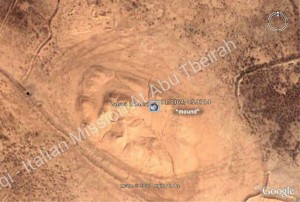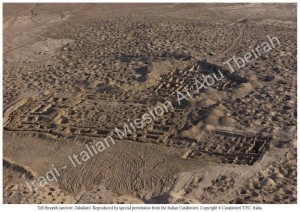Modern name:
Tell Ibzaykh
Ancient name:
Zabalam
Geographic coordinate:
31° 44′ 11.3999″ – 45° 52′ 16.6800″
31.7365° N – 45.8713º E
Governatorate – District – Sub-district:
Dhi-Qar – al-Rifa’i – Qalat Sukar
Nearest City:
Zabalam is in a sparsely populated region about 18 kilometers north of Umma and 22 km south-west of modern Qalat Sukar.
Chronological frame:
Jemdet Nasr – Early Dynastic- Akkadian (3000–2200 BC)
Excavations:
Excavated by the State Board of Antiquities and Heritage in the 1990’s. Extensively looted.
Description:
The most noticeable feature of the site is the mound (probably the remnants of a ziggurat) which extends some 30 to 40 meters above the plain (see mound coordinates). The first mentions of Zabalam are in seals from the Jemdet Nasr period including a list of early cites – Ur, Nippur, Larsa, Uruk, Kesh, and Zabalam. The earliest historical record, a bowl inscription, indicates that Zabalam was under the control of Lugalzagesi of Lagash. In the Sargonic Period, Shar-kali-sharri and Naram-Sin both reported building a temple to the goddess Inanna in Zabalam. After the fall of Akkad, Zabalam came into the sphere of the city-state of Isin as reported by the year names of several rulers including Itar-pisa and Ur-Ninurta. The town was later subject to Abisare of Larsa, who’s year name reported the building of the “Favorite of Inanna of Zabalam” canal. During the Ur III period, Zabalam was controlled by the Ur governor in Umma which was the capital of Umma Province. Cuneiform texts state that Hammurabi built Zabalam’s temple Ezi-Kalam-ma to the goddess Innana. The temple of Inanna in Zabalam is the subject of hymn 26 of Enheduanna.
Beginning in the early 1900s, a great deal of illegal excavations occurred . In the same year the Iraqi State Organization of Antiquities and Heritage appears to have authorized an official excavation, the first at the site. A further outbreak of archaeological looting broke out after the 2003 War in Iraq.
Nome moderno:
Tell Ibzaykh
Nome antico:
Zabalam
Coordinate Geografiche:
31° 44′ 11.3999″ – 45° 52′ 16.6800″
31.7365° N – 45.8713º E
Governatorato-Disretto-Subdistretto:
Dhi-Qar – al-Rifa’i – Qalat Sukar
Città vicine:
Zabalam si trova in una regione scarsamente popolata a circa 18 chilometri a nord di Umma e 22 km a sud-ovest della moderna Qalat Sukar.
Quadro cronologico:
Jemdet Nasr-Protodinastico- periodo Accadico (3000-2200 a.c.)
Scavi:
Scavata dalla commissione statale dell’antichità e del patrimonio nel 1990. Ampiamente saccheggiata.
Descrizione:
La caratteristica più evidente del sito è il tumulo (probabilmente i resti di una ziggurat) che si estende per circa 30-40 metri sopra la pianura (vedi coordinate tumulo). La prima menzione di Zabalam è nei sigilli del periodo Gemdet Nasr che include le prime di città- Ur, Nippur, Larsa, Uruk, Kesh, e Zabalam. La prima testimonianza storica, una ciotola iscritta, indica che Zabalam era sotto il controllo di Lugalzagesi di Lagash. Nel periodo Sargonico, Shar-kali-Sharri e Naram-Sin hanno riportato la costruzione di un tempio dedicato alla dea Inanna in Zabalan. Dopo la caduta di Akkad, Zabalam entra nella sfera della città-stato di Isin come hanno riportano i nomi di i anno di diversi sovrani, tra cui Itar-pisa e Ur-Ninurta. La città fu poi soggetta ad Abisare di Larsa, il cui nome di anno ha riportato la costruzione del canale “La favorita di Inanna di Zabalam”. Durante il periodo di Ur III, Zabalam era controllata dal governatore di Ur in Umma, che era la capitale della provincia di Umma. Testi cuneiformi affermano che Hammurabi costruì il tempio Ezi-Kalam-ma di Zabalam alla dea Innana. Il tempio di Inanna è oggetto dell’ inno 26 di Enheduanna. A partire dagli inizi del 1900 c’è stato una grande quantità di scavi illegali. Nello stesso anno l’Organizzazione irachena statale di antichità e Patrimonio sembra aver autorizzato uno scavo ufficiale, il primo presso il sito. Un ulteriore focolaio di saccheggio archeologico è scoppiato dopo la guerra del 2003 in Iraq.

